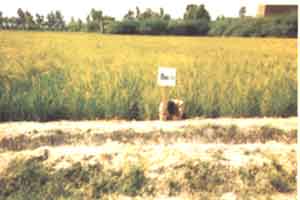|
Pakistan Agriculture overview |
The Use of gypsum for sodic soils
About six million hectares of land in Pakistan is salt-effected. Of this,
more than fifty per cent soils are saline-sodic.This is a severe constraint to
crop productivity. Gypsum is one of the effective reclaiming amendments. Lots of
local reserves Of gysum are available. However, the sale price to farmers high
due to processing and transportation costs. gypsum being marketed is
questionable. The results is that farmers do not use adequate quantities.
In Pakistan, about 6 million hectares are affected
completely or partially by salinity and sodicity. Soil
sodicity often follows soil salinity. Of these salt-affected
soils, about 56 per cent are saline-sodic or sodic and are
not easily reclaimable. These soils besides other problems.
suffer from poor water infiltration. Soil sodicity is,
indeed, a very severe land degradation problem.
Technically, sodium (Na+) is a predominant ion in sodic
soils which occupies the exchange complex of the soil
As a result, the soil panicles arc unable to sack together
as aggregates, and hence, the soil becomes unstable and
impermeable 10 air, water and to plant roots. The pH
increases to more than 8-5, and the soil becomes barren
and unproductive.
Reclamation of sodic soils
Sodic soils can be reclaimed effectively by providing a
soluble source of calcium e.g. gypsum, or some acids
or acid formers which can solublize the native calcium
carbonate of the soil. Some other substances which
have proved effective, include sulfur, and iron sulfates,
which after direct application in the field form gypsum
in soils. Even green manuring and farmyard manure
has been used successfully, but gypsum is the
cheapest and most effective amendment for reclaiming
sodic areas.
Gypsum as soil amendment
 Powdered gypsum is used for the reclamation of
sodic soils, where pH and exchangeable sodium percentage (ESP) of sodic soils is too
high (pH >8.5 and ESP >15). For soil improvement and better crop growth,
these must be decreased to safer limits. The calcium supplied by gypsum,
replaces the sodium held on the exchange complex. The sodium can then be
leached out from the soil as sodium sulfate to a suitable depth with heavy
irrigations. As a result, the soil becomes fit for growing normal crops. Powdered gypsum is used for the reclamation of
sodic soils, where pH and exchangeable sodium percentage (ESP) of sodic soils is too
high (pH >8.5 and ESP >15). For soil improvement and better crop growth,
these must be decreased to safer limits. The calcium supplied by gypsum,
replaces the sodium held on the exchange complex. The sodium can then be
leached out from the soil as sodium sulfate to a suitable depth with heavy
irrigations. As a result, the soil becomes fit for growing normal crops.
Gypsum requirements and use
To determine the amount of gypsum
powder required to reclaim a certain soil,
samples are collected from the affected
area from 0-15 and 15-30 cm depths
from different locations. The soil is
analyzed for electrical conductivity, pH
and ESP to assess the degree of
degradation and gypsum requirement
(GR) calculated. In a field experiment
conducted to compare the effect of
different amendments, the data indicated
that paddy yield was 66 per cent and
wheat 102 per cent higher than control,
where gypsum was applied @ 50 per
cent GR along with 50 tonnes ha-1 of
farm yard manure (FYM).
Combination of gypsum with FYM
accelerated the reclamation process and
consequently increased the crops yield.
The infiltration rate also increased
significantly candy.
Instituting a successful reclamation
program
Important factors which must be considered before starting a reclamation
programme are the presence of proper
drainage and availability of good quality
irrigation water. Approximately one acre-
foot of irrigation water is required for
complete dissolution of one tonne of
gypsum powder. Hence, heavy irrigations
should be applied for complete
dissolution of applied gypsum. Proper
season for reclamation of sodic soils is
summer and rice should be preferred as
the first crop- Other important factors
which control the efficiency of gypsum
for reclamation of sodic soils are its
purity and mesh size- Mostly 60-80 mesh
size of gypsum powder is recommended
for reclamation purposes. Coarser sizes
are considerably less efficient while for
finer mesh sizes, cost of grinding
becomes a prohibitive factor. Similarly,
purity of gypsum should not be less than
80 per cent.
Treating sub-soil sodicity salinity
In some cases, these reclamants may not
solve the sodicity problem completely.
For example, very large quantities of
gypsum may be needed if [he farmer
wants to have a long-term effect.
Similarly, sub-soil sodicity may not be
ameliorated by the addition of gypsum
at the surface, unless the soils are also
deeply ripped to facilitate the penetration
of water.
Effect of gypsum on soil amelioration
was studied in a field experiment on a
clay loam, dense sodic soil in a long term
field study by growing two wheat and
two rice crops in succession. Brackish
water was used for irrigation. Data indicated that gypsum application with
ripping was much more effective.
An innovative approach
 Gypsum powder is applied according to
gypsum requirement and mixed in the
sodic soil. A heavy irrigation with good
quality irrigation water is applied and Gypsum powder is applied according to
gypsum requirement and mixed in the
sodic soil. A heavy irrigation with good
quality irrigation water is applied and
thorough mixing is done with the help
of a wooden plank pulled by the tractor.
After 3-4 hours, the stagnant water is
then flushed and removed to a nearby
pond or surface drain. In this way
harmful sodium is removed from the
soil along with excessive amount of other
salts. Thus, the soil environment becomes
favourable for most of the moderately
salt-tolerant crops such as wheat and
rice. Significant yield increase was noted
in the first rice crop grown after the
treatments.
Gypsum improves quality of brackish water
Poor quality irrigation water is very
hazardous for soil health. With
continuous and indiscriminate use of
such unfit waters, the soil becomes sodic
and penetration of water and air is
hampered. Gypsum helps to ameliorate
the pour quality brackish irrigation waters.
Lining of water channels with gypsum
stones is recommended to modify the
irrigation water quality- of tube wells.
The length of watercourse to be lined
with gypsum will depend on the quality
of water: the poor the quality, the more
the length of water course. However, it
is advisable to use die gypsum stones in brick lined water channels to avoid
water
seepage.
Pest-reclamation care
After reclamation, only good quality
water should be used for irrigation. To
ensure that salinity does not reoccur, an
excessive amount of water must be added
so that the amount of salt added is equal
to the amount of salt leaving the root
zone. Excess water can, however, create
problems of high water table, which
should be duly looked after.
The problem
Present usage of gypsum does not
commensurate with the gravity' of the
problem. The fact of the matter is that
gypsum is generally not available to the
farmer when he needs it. Its cost is also
beyond his means- The result is that the
technology, howsoever good, is of no
avail unless the farmer can practice it.
Plenty of raw material is available in the
country. It is the cost of its
transportation, crushing and bagging
which constitute the major components
of its sale price. Besides, the product
quality often is below the standard. The private sector is not very aggressive
because they have a low margin of profit
Previously [he government provided
subsidy on its sale which is no longer
there. Farmers' access to credit facilities
for the purchase of gypsum is another
bottleneck constraining its use.
Promoting the use of gypsum
Beneficial effects of gypsum for the
reclamation of sodic soils, crop yields
and for amelioration of brackish waters
have been demonstrated extensively to
the farmers by different federal and
provincial research and extension
departments. However, the use of
gypsum has not increased at farm level,
especially with the small farmers.
The problem was discussed in a
workshop arranged by the Pakistan
Agricultural Research Council, Islamabad
and held on April 9-10, 2001 at the
National Agricultural Research Centre,
Islamabad. It was participated by
researchers, representatives of gypsum
industry, farmers and NGOs. The
following recommendations were
formulated.
 • Use of gypsum may be encouraged
along with FYM/green manures. • Use of gypsum may be encouraged
along with FYM/green manures.
• Quality and purity of gypsum, not
less than 70 per cent, should be
legally ensured and effectively
monitored.
Ground water quality maps be
developed on district basis through
special projects.
Credit facilities should be provided
in kind and its recover' be made in
easy installments when the land
becomes productive.
Land revenue may be exempted from
the lands under reclamation till they
become productive.
A board be constituted to monitor
and ensure the supply, quality and finess of gypsum. This board
should include the representatives
of farmers, suppliers and
scientists. FO
|
Other Overviews
|
DISCUSS
issue
problems
at
Pakissan Forum
Connect with
the
Pak Agri Community
|
Register
Today at
Pak
APIN
(Pakissan
Agri Experts and Institutes Network)
& become
part of the
Agri
Community
of
Pakistan
|
|
|